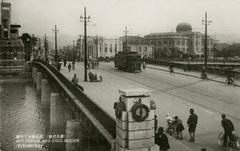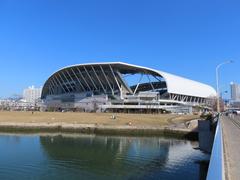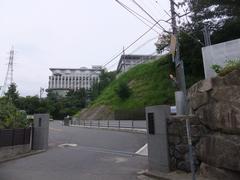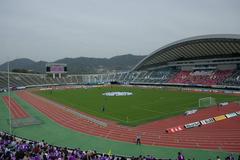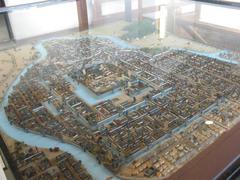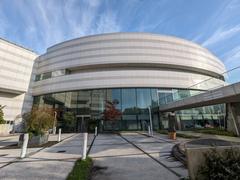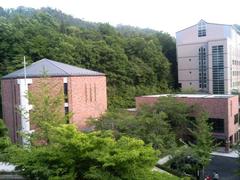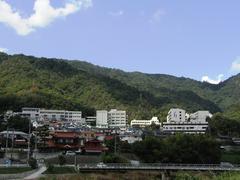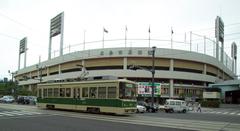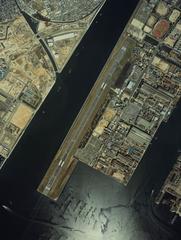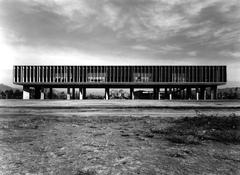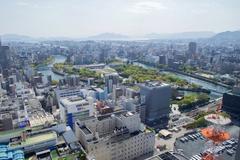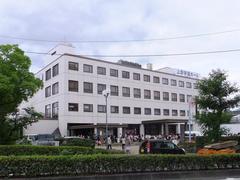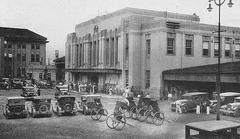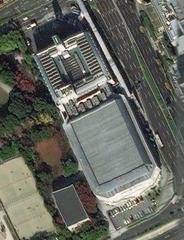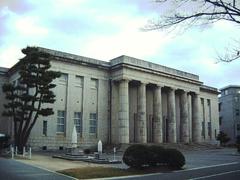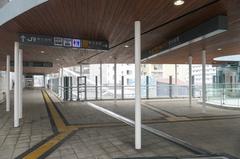Seno Station Hiroshima: Comprehensive Visiting Guide, Tickets, History, and Nearby Attractions
Date: 04/07/2025
Introduction to Seno Station, Hiroshima: Gateway to History and Community
Located in Aki Ward, Hiroshima City, Seno Station (瀬野駅, Seno-eki) is more than just a transit hub—it’s a living symbol of the region’s transformation, resilience, and ongoing cultural vitality. Established in 1894 as part of the Sanyo Railway, the station has long served as a critical connector between rural communities and urban centers, helping drive Hiroshima’s economic and social development (Explore Hiroshima). Seno Station has witnessed Hiroshima’s complex history, from wartime hardship to postwar recovery, and continues to play an essential role in the city’s daily life and peace legacy (Hiroshima Prefectural Office).
Today, Seno Station offers modern amenities such as barrier-free facilities, automated ticketing, and multilingual support. It is a starting point for exploring both local temples and Hiroshima’s world-renowned historical sites, including the Peace Memorial Park and Shukkeien Garden. This guide provides detailed information on visiting hours, ticketing, accessibility, travel tips, and must-see attractions, ensuring you experience both the functional and symbolic facets of Seno Station and its surroundings (Travel + Leisure Asia; JR West).
Contents
- Historical Overview: Seno Station’s Establishment and Regional Impact
- Seno Station’s Role in Hiroshima’s Postwar Recovery
- Modern Facilities and Accessibility
- Cultural and Community Highlights
- Visitor Information: Hours, Tickets, Accessibility, and Travel Tips
- Nearby Attractions and Nature Spots
- Seno Monument: Commemorating Local Heritage
- Frequently Asked Questions (FAQ)
- Visual Gallery and Media Resources
- Practical Tips and Sustainable Tourism
- Conclusion and Key Takeaways
- Sources and Further Reading
Historical Overview
Early Development and Regional Context
Opened in 1894, Seno Station was integral to the expansion of the Sanyo Railway, which linked the Chugoku region with broader Honshu. Its position in Aki Ward, then a primarily agricultural area, allowed for the efficient movement of goods and people, accelerating local economic growth. Nationalization of the Sanyo Railway brought the station under Japanese Government Railways and, later, the privatized JR West.
Seno Station’s Role in Hiroshima’s Postwar Recovery
While Seno Station was outside the direct atomic bombing zone in 1945, the devastation of Hiroshima’s infrastructure made the station a crucial conduit for relief operations, evacuation, and later, the city’s reconstruction efforts. Rail connections through Seno enabled supplies, personnel, and survivors to flow, symbolizing the city’s resilience (Hiroshima Prefectural Office).
Modern Facilities and Accessibility
Seno Station has undergone numerous upgrades since the mid-20th century, including electrification of the Sanyo Main Line and the addition of barrier-free features. Facilities now include:
- Automated ticket gates and multilingual vending machines
- Barrier-free access with elevators and ramps
- Accessible restrooms and waiting areas
- Staffed Midori no Madoguchi ticket office
- Real-time information displays
- Security features and surveillance cameras
These improvements ensure comfortable travel for all visitors, including those with mobility needs (Travel + Leisure Asia; JR West).
Cultural and Community Highlights
Seno Station remains a focal point for local festivals and community life. It is a gateway to the scenic hills and rivers of Aki Ward and serves as a launch point for exploring temples, shrines, and rural landscapes. The station’s understated architecture and enduring presence are emblematic of the practical, community-focused ethos of regional Japan (Explore Hiroshima Culture).
Visitor Information: Hours, Tickets, and Travel Tips
Visiting Hours
- Station Operating Hours: Daily, from approximately 5:00 AM to midnight.
- Staffed Ticket Office: Typically 6:00 AM to 10:00 PM.
- Automated Machines: Available 24/7.
Ticketing Options
- Japan Rail Pass: Accepted for JR West network travel.
- Local and Express Tickets: Purchase at ticket office or vending machines.
- IC Cards: ICOCA, Suica, and PASMO supported for trains and buses.
For up-to-date fare details: JR West official ticketing page.
Accessibility
- Fully barrier-free, with elevators, ramps, and tactile paving
- Accessible restrooms and multilingual signage
- Staff available for assistance
Travel Tips
- Peak Times: Morning (7–9 AM) and evening (5–7 PM) on weekdays
- Luggage: Small coin lockers available; for larger luggage, use Hiroshima Station
- Language Support: English-speaking staff and clear signage
Nearby Attractions and Nature Spots
Historical and Cultural Sites
- Hiroshima Peace Memorial Park: <30 minutes by train/tram from Seno Station
- Shukkeien Garden: Historic garden near Hiroshima Station
- Hiroshima Castle: Accessible via Hiroshima Station
Local Nature and Recreation
- Seno Highlands (瀬野高原): Popular for hiking, cherry blossom viewing, and autumn foliage
- Seno River: Scenic walking and cycling paths
- Mitaki-dera Temple: Noted for waterfalls and seasonal colors
Unique Local Experiences
- Skyrail Midorizaka Line: Monorail experience to Midorizaka New Town
- Local Festivals: Obon, harvest matsuri, and Hiroshima Kagura performances
Seno Monument: Celebrating Community Heritage
The Seno Monument stands as a tribute to the area’s history and community.
Erected in 1985, the Seno Monument is a short walk from the station and commemorates the district’s industrial and social development. The open-air site is free to visit year-round—recommended hours are 8:00 AM to 6:00 PM for safety and the best viewing. Occasional community-led guided tours and seasonal events are held at or near the monument.
Practical Information
Getting There
- From Hiroshima Station: 15 minutes by JR West Sanyo Main Line (eastbound)
- By Bus: Local routes connect Seno with Hiroshima Bus Center
- By Bicycle: Scenic 13 km ride from central Hiroshima
Facilities and Services at Seno Station
- Barrier-free design and accessible restrooms
- Bicycle parking
- Convenience stores and vending machines
- Taxi stand and bus connections
Frequently Asked Questions (FAQ)
Q: What are Seno Station’s hours?
A: Approximately 5:00 AM to midnight; staffed services from 6:00 AM to 10:00 PM.
Q: Can I buy tickets in English?
A: Yes, both at the staffed office and multilingual vending machines.
Q: Is the station accessible for wheelchair users?
A: Yes, with elevators, ramps, and accessible restrooms throughout.
Q: How do I get to the Seno Monument?
A: Five-minute walk north from Seno Station; accessible and free.
Q: Are guided tours available?
A: Occasionally, through local groups—check tourism websites or station notices.
Visual Gallery and Media Resources
- Images of Seno Station’s platforms, concourse, and the Seno Monument
- Photos of cherry blossoms, hiking trails, and community festivals
- For virtual tours and maps, see Explore Hiroshima Culture and Travel + Leisure Asia.
Practical Tips and Sustainable Tourism
- Seasonal Visits: Spring and autumn offer the best scenery.
- Local Cuisine: Try Hiroshima-style okonomiyaki and fresh oysters at nearby eateries.
- Community Engagement: Participate in local clean-up days, festivals, or cycling tours.
- Sustainable Choices: Support local businesses and respect community etiquette.
Conclusion and Key Takeaways
Seno Station is more than a stop on the map—it’s a gateway to Hiroshima’s rich tapestry of history, nature, and community life. Its blend of modern amenities, accessibility, and local charm make it ideal for both daily commuters and travelers seeking authentic experiences. Use resources like the Audiala app and official tourism websites to plan your visit, and immerse yourself in the unique spirit of Hiroshima starting at Seno Station.
Sources and Further Reading
- Seno Station Visiting Hours, Tickets, and Historical Significance in Hiroshima, 2025, Explore Hiroshima (Explore Hiroshima)
- Hiroshima Prefectural Office Peace Legacy, 2025 (Hiroshima Prefectural Office)
- Travel + Leisure Asia: Beyond Tragedy - Explore the Resilience and Beauty of Hiroshima (Travel + Leisure Asia)
- JR West Official Website, 2025 (JR West)
- Seno Station Visiting Guide: Hours, Tickets, Facilities, and Nearby Attractions in Hiroshima, 2025, JR West (JR West Tickets)
- Explore Hiroshima Culture, 2025 (Explore Hiroshima Culture)
- JR West Timetable
- Live Japan
- Dive! Hiroshima
- Japan Guide
